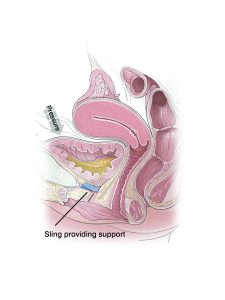Conditions & Treatments For Men Urinary Incontinence in Men Stress Urinary Incontinence in Men Treatment for Stress Urinary ...
Treatment for Stress Urinary Incontinence in Men
First Line Therapies
Your urologist will begin treating your stress incontinence with first-line therapies that may include:
- Physical therapy – Physical therapy strengthens the pelvic floor muscles. Pelvic floor muscle exercises can help prevent urine leakage by strengthening the pelvic floor and sphincter muscles.
- Pelvic rehabilitation – Following a radical prostatectomy, rehabilitating the pelvic floor muscles can help stop urine leakage.
- Fluid and diet management – Changing the amount of fluid intake during the day, as well as avoiding common dietary irritants such as caffeine and tomato-based foods, may help bladder function.
- Healthy lifestyle changes – Losing excess weight and quitting smoking (which leads to a chronic cough) can help eliminate some pressure on your bladder.
 Surgical Treatments
Surgical Treatments
- Male urethral sling – For men who have not responded to behavioral therapy, a synthetic mesh sling surgically implanted to provide support to the urethra may help restore continence. Many men have success with the sling and see improvement in leakage following the surgery. Like any surgical procedure, the male sling does have its risks. Speak to your doctor to learn about the benefits and risks.
- Artificial Urinary Sphincter – The artificial urinary sphincter is an implantable device equipped with an inflatable cuff that fits around the urethra. This cuff replaces the natural sphincter that has been compromised and prevents urine leakage associated with stress urinary incontinence. Learn more about the artificial urinary sphincter here.
- Urethral bulking – Urethral bulking involves the injection of a special material called a bulking agent around the urethra. The bulking agent helps build up the thickness of the urethral wall to increase the outlet resistance to minimize urine leakage. However, bulking agents in men have proven to be a less effective treatment than other surgical options.
